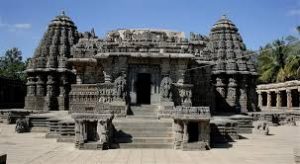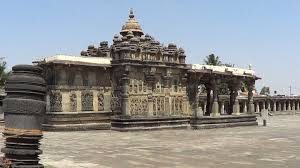Hoysals of Dwarsamudra
The Hoysalas ruled a large part of modern day Karnataka and parts of Andhra Pradesh and Tamil Nadu from the 10th to the 14th century. Historians consider them to have been natives of the Malnad region in Karnataka but inscriptions also point towards connections with the Yadavas from North India.
The Hoysala Empire was founded by King Nripa Kama II who is remembered to having built an alliance with the Western Ganga dynasty. He was succeeded by his son Vinayaditya who was followed by his son and their sons until Veera Ballala I who died childless and was succeeded by his younger brother Vishnuvardhana Raya.
In the history of Hoysalas the name, Vishnuvardhana Raya holds great importance. It was under King Vishnuvardhana Raya that the kingdom achieved political prominence. Of his many military conquests, he is best known for winning the Gangawadi area from Cholas/”>The Cholas in 1116.
It was also under his reign that the influence of Sri Ramanujacharya spread in the Karnataka region and Srivaishnavism grew in popularity. Vishnuvardhana Raya himself was originally known as Bittideva and took on this name only after converting from Jainism to Srivaishnavism.
A number of Vaishnava temples were built under his patronage while his queen, Shantala Devi who remained a devout Jain, fostered a number of artists.
In the late 1100s, King Vishnuvardhana Raya’s grandson, Veera Ballala II freed the Hoysalas from the Chalukya subordination and established an independent kingdom. Kannada folklore suggests that he founded the city of Bangalore. He was succeeded by his son; Narasimha II who in turn was succeeded by his son, Vira Someshwara. Civil war broke out under his reign and the kingdom was partitioned into two parts and ruled by his sons, Narasimha III and Ramanatha.
Veera Ballala III, the son of Narasimha III is considered the last ruler of the Hoysala dynasty. He reunified the kingdom but after his death at the battle of Madurai in 1343, the kingdom disintegrated and was merged with other empires.
Today, the empire is remembered mainly for its Temple Architecture rather than its military conquests. There are over a hundred temples from this era still standing in various parts of Karnataka. Three of the most well-known Hoysala Temples are the Kesava Temple at Somanathapura, Chennakesava Temple at Belur and Hoysaleswara Temple at Halebidu.
Kesava Temple, Somanathapura
The Chennakesava Temple or Kesava Temple at Somanathapura was built under King Narasimha III in 1268 C.E. This is considered a Vaishnava Temple and has three shrines devoted to the different avatars of Lord Vishnu. The temple is built from soapstone and is known for its lathe turned pillars, symmetrical architecture and intricate sculptures.
Chennakesava Temple, Belur
Belur was originally the capital of the Hoysala Kingdom. In 1117 AD King Vishnuvardhana commissioned the building of this temple which was originally named the Vijayanarayana Temple. Scholars stand divided on whether it was built to celebrate his victory over the Cholas in the battle of Talakad or to commemorate his conversion from Jainism to Hinduism-2/”>Hinduism.
The temple itself marks the development of a new Architectural style. It is also renowned for the 48 unique pillars inside the main hall. Of these the Narasimha pillar and Mohini Pillar are the most well-known.
Hoysaleswara Temple, Halebidu In the 12th Century, the Hoysala capital shifted to Halebidu under the rule of King Vishnuvardhana. It is said that the rich an influential Shaiva followers of the city initiated the construction of this temple in competition with the Chennakesava Temple in Belur. This temple is best known for its intricately carved sculptures.
,
The Hoysalas were a Hindu dynasty that ruled over parts of southern India from the 11th to the 14th centuries. They were known for their military prowess, their patronage of the arts, and their construction of some of the most beautiful temples in India.
The Hoysalas originated in the Deccan Plateau, and their first capital was at Belur. In the 12th century, they moved their capital to Dwarasamudra (modern-day Halebidu). The Hoysalas reached the height of their power under the reign of Vishnuvardhana (1108-1152). Vishnuvardhana was a great warrior who expanded the Hoysala kingdom and defeated many of his enemies. He was also a patron of the arts and commissioned the construction of many beautiful temples.
Hoysala architecture is characterized by its intricate carvings and sculptures. The Hoysalas were master builders, and their temples are some of the most impressive examples of Hindu architecture in India. The most famous Hoysala temples are at Belur, Halebidu, and Somnathpur.
Hoysala art is also known for its beauty and sophistication. Hoysala artists excelled in painting, sculpture, and metalwork. Some of the finest examples of Hoysala art can be found in the temples at Belur, Halebidu, and Somnathpur.
The Hoysala dynasty came to an end in the 14th century, when they were defeated by the Delhi Sultanate. However, their legacy lives on in the beautiful temples and monuments that they built.
Hoysala temples are some of the most impressive examples of Hindu architecture in India. They are known for their intricate carvings and sculptures, as well as their elegant proportions. The most famous Hoysala temples are at Belur, Halebidu, and Somnathpur.
The Belur temple was built in the 12th century by Vishnuvardhana. It is dedicated to the Hindu god Vishnu. The temple is a masterpiece of Hoysala architecture, and it is decorated with intricate carvings and sculptures.
The Halebidu temple was also built in the 12th century by Vishnuvardhana. It is dedicated to the Hindu god Shiva. The temple is even more impressive than the Belur temple, and it is considered to be one of the finest examples of Hoysala architecture.
The Somnathpur temple was built in the 13th century by Somanatha. It is dedicated to the Hindu god Vishnu. The temple is smaller than the Belur and Halebidu temples, but it is no less impressive. It is decorated with intricate carvings and sculptures, and it is considered to be one of the finest examples of Hoysala architecture.
The Hoysalas were a great dynasty that left a lasting legacy on India. Their temples are some of the most beautiful and impressive examples of Hindu architecture in the world.
Here are some frequently asked questions and short answers about the Hoysalas of Dwarsamudra:
What is the Hoysala dynasty?
The Hoysala dynasty was a Hindu dynasty that ruled over parts of southern India from the 11th to the 14th centuries. The Hoysalas were originally from the Deccan Plateau, but they moved to the southern part of the peninsula in the 11th century. They established their capital at Dwarsamudra (modern-day Halebidu), in what is now Karnataka state.Who were the most important Hoysala rulers?
The most important Hoysala rulers were Vishnuvardhana, Ballala I, and Narasimha III. Vishnuvardhana was the founder of the Hoysala dynasty. He was a powerful ruler who expanded the Hoysala kingdom. Ballala I was the son of Vishnuvardhana. He was a successful military commander who defeated the Chola dynasty. Narasimha III was the grandson of Ballala I. He was a great patron of art and architecture.What are some of the Hoysalas’ most important achievements?
The Hoysalas were known for their military prowess, their patronage of art and architecture, and their construction of temples. The Hoysalas were also known for their Tolerance of other religions.What are some of the Hoysalas’ most important temples?
Some of the Hoysalas’ most important temples include the Chennakeshava Temple in Belur, the Hoysaleswara Temple in Halebidu, and the Virupaksha Temple in Hampi. These temples are all UNESCO World Heritage Sites.What happened to the Hoysala dynasty?
The Hoysala dynasty declined in the 14th century. This was due to a number of factors, including the rise of the Vijayanagara Empire, the decline of trade, and the invasion of the Delhi Sultanate.What is the legacy of the Hoysalas?
The Hoysalas left a rich legacy in the form of their temples, their art, and their architecture. Their temples are some of the finest examples of Hindu architecture in India. The Hoysalas also made significant contributions to the development of Kannada literature and culture.
- The Hoysalas were a dynasty that ruled over parts of southern India from the 11th to the 14th centuries. They were known for their architecture, which is characterized by its intricate carvings and sculptures.
- The Hoysala capital was at Dwarasamudra, which is now known as Halebidu in Karnataka.
- The Hoysalas were patrons of the arts and literature. They built many temples and other monuments, and they supported many poets and scholars.
- The Hoysalas were eventually overthrown by the Vijayanagara Empire in the 14th century.
Here are some MCQs about the Hoysalas:
Which of the following is not a characteristic of Hoysala architecture?
(A) Intricate carvings and sculptures
(B) Large, open spaces
(C) Use of red sandstone
(D) Use of white marbleWhich of the following is not a Hoysala monument?
(A) The Chennakeshava Temple
(B) The Belur Temple
(C) The Halebidu Temple
(D) The Hampi TempleWhich of the following is not a Hoysala king?
(A) Vishnuvardhana
(B) Ballala I
(C) Vira Ballala III
(D) KrishnadevarayaThe Hoysalas were eventually overthrown by which of the following empires?
(A) The Chola Empire
(B) The Pandya Empire
(C) The Vijayanagara Empire
(D) The Mughal EmpireThe Hoysalas were known for their patronage of which of the following?
(A) The arts and literature
(B) Science and technology
(C) Trade and Commerce
(D) agriculture and Irrigation

